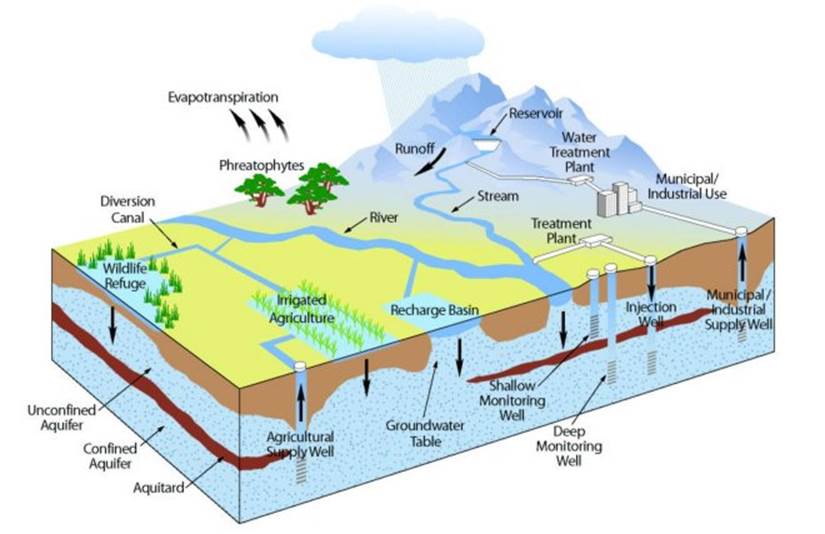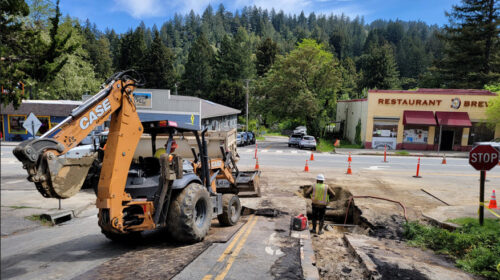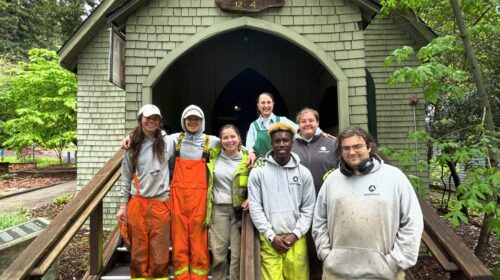Commentary: Santa Margarita Groundwater Agency
By Bob Fultz
Hopefully everyone in the San Lorenzo Valley Water District (SLVWD) has heard of the Santa Margarita Groundwater Agency (SMGA). But, if not, I hope this will be a good start since there are critical decisions coming soon that will impact both our environment and our pocketbooks. I’m speaking for myself in this article—I’m not speaking on behalf of the management or Board of the SLVWD.
The SMGWA was formed in June 2017 following the enactment of the Sustainable Groundwater Management Act of 2014 (signed into law in September 2014). The formation agreement is here: http://smgwa.org/wp-content/uploads/2017/01/Santa-Margarita-Groundwater-Agency-JPA-Final-signed.docx.pdf. According to the SMGWA website, this act “…empowers local agencies to achieve sustainability within 20 years. SMGWA establishes minimum standards for sustainable groundwater management, improves coordination between land use and groundwater planning, provides state technical assistance, protects water rights, and creates a mechanism for state intervention if a local agency is not managing its groundwater sustainability.”
In the wake of the horrible drought of 2011 – 2017, concerns about over-using groundwater resources became more urgent since many aquifers in California are much lower than just a couple of decades ago. In our area, from about the late 70s to 2015, we used more water from the Santa Margarita groundwater basin (composed of several aquifers) than was being replaced, primarily due to rapid population growth. However, due to many water conservation measures undertaken by our local agencies, the groundwater levels have recently stabilized.
As part of the law, and based on its historical use, the Santa Margarita groundwater basin was designated as “moderately over-drafted.” This means that the affected agencies and communities MUST develop a plan acceptable to the State of California and submit it by January 2022. Under state law, this plan is not optional. If we don’t do it the state will step in and do it for us. And the state will not have the same sensitivity to costs, risk, efficacy or environmental impacts.
According to the SMGWA website (www.smgwa.org) and formation agreement, the agency is governed by a 11-person board with membership as follows: 2 members each from the Scotts Valley Water District, San Lorenzo Valley Water District, the County of Santa Cruz and the Well Owners in the affected region PLUS 1 member each from the City of Santa Cruz, City of Scotts Valley and the Mt. Hermon Association Community Water System. The current budget for FY21 is ~$1,200,000 of which SLVWD’s share is 30% or ~$360,000. Fortunately, for now, partial grant funding brings down our actual cost to ~$145,000. But grant funding eventually goes away so it’s important that we focus on future operational costs as well. Had grant funding not been available, each SLWVD customer would be paying ~$45 this fiscal year to support this effort or just under $4 per month.
The City of Santa Cruz is involved because they own and operate the Loch Lomond reservoir and they extract 47% of their water directly from the San Lorenzo River.
In lay terms, the SMGWA’s main charter, and plan focus, is to develop methods focused on sustainability—to keep the groundwater level at no less than 2015 level over the remaining 15 years—and longer. However, beyond sustainability it’s prudent to investigate ways to recharge the basin to provide a buffer in the event of drought, as we may be seeing now. Since our county is not connected to any of the state or federal water projects, the only way to recharge our basin is to use the resources available to us: rainy season rainfall and runoff and overall water usage.
Let’s look at overall water usage first. Over many years, the SLVWD community has significantly reduced overall indoor water usage to a point where our community uses between 38 and 44 gallons per person per day. Once the 2020 census in published we’ll be able to refine these calculations. But since the state goal is 50 gallons per person per day, we are already well below that. We should certainly maintain this level and we can probably do somewhat better but the big reductions have already been achieved. Plus, the SLV community is undergoing a demographic shift as more younger families move in, meaning the total water use will go up as population increases even if our daily usage stays the same.
Therefore, it’s not clear that conservation alone achieves the sustainability goal.
In this document: https://smgwa.org/wp-content/uploads/2020/06/ProjectsSMGWA_June2020_Final.pdf, on page 9, the SMGA has identified five primary methods for recharging the groundwater basin. I’m going to focus on two of them for this article. Simply put, these two options use excess surface water generated during the rainy season to either (a) forcibly inject treated water into the basin or (b) distribute treated water more broadly during the rainy season—meaning neither SVWD or SLVWD have to use their wells.
As additional background, SVWD obtains almost all of their water from wells pumping out of the Santa Margarita groundwater basin. SLVWD obtains about 50% of its water from surface sources and about 50% from wells pumping out of the Santa Margarita groundwater basin, meaning that the SLVWD already rests its wells during the rainy season. Santa Cruz obtains almost all of their water from surface sources—Loch Lomond (Newell Creek), San Lorenzo River and surface sources north of Santa Cruz.
On closer examination, both options: (a) contemplate using excess surface water and runoff, (b) require that the excess surface water be treated, and (c) require excess surface water be moved from its source to another location. In other words, the ongoing operating costs—treating and moving (pumping) the water, will be similar for both options. Likewise both options have similar environmental considerations associated with using the excess surface water.
As with any major public initiative, we have to understand the costs for each option, both upfront and operating, before making a decision.
Injection wells are expensive to build. Using costs from other districts that have selected this approach, the best estimate is somewhere between $10 – $20 million for each new well. Modifying an existing well may cost between $5 – $10 million. Assuming that the costs are split per the current SMGA formula, the SLVWD customers would pick up 30% of this or $4.5 – $6 million for new wells and $1.5 – $3 million for retrofitting existing wells. So that means each SLVWD customer would be responsible for $200 to $750 in construction costs—for each well—and the estimates are that multiple wells would be needed—perhaps as many as 6 wells. Over a 30-year bond the total amount paid is about twice the amount borrowed. Bottom line, this is an additional $1 – $4 per month per customer per well on top of your existing water bill or $6 – $24 per month if 6 wells are constructed. I do not have operating costs per year but there will be some—at least inspection, testing and periodic maintenance—and those costs will go up every year over the life of the 30-year bond. And this will be on top of the forecasted rate increases for our normal water delivery, which have been substantial over the past few years.
In addition, there are efficacy concerns. Again, using information from other districts that have selected this approach, not all wells are successful. And that would be clear until the well was constructed and in use. It’s important for us to consider if our small communities and associated modest financial resources should be on the vanguard of this technology given the costs and risks.
By contrast, the second option of distributing excess surface water more broadly requires much less capital investment. The SLVWD and SVWD are already connected via an emergency intertie. If the state removes the “emergency only” designation from the intertie then excess surface water sales to SVWD could start as soon as SLVWD repairs the fire damage to the collection pipes interconnecting our surface water sources. Alternatively, the Santa Cruz Water Department could initiate their own interconnection project and, in a couple of years, could also be connected to the SVWD, giving the SVWD additional options for resting their wells. If our community decides to go with this option then we will need to, as a community, decide which surface water sources to use.
Finally, we need to discuss which option has the greatest potential for groundwater recharge. For the first option (injection wells), the recharge potential is linear—more wells means more recharge potential. However, the efficacy of each well isn’t known—for sure—until the construction costs are spent. That’s higher risk. For the second option, it depends on how much water the SVWD uses during periods of higher rainfall because that is how much water isn’t being extracted from the groundwater basin.
I’ve constructed a table below summarizing the points that we, as a community, must consider while making this decision.
One last item. While our community has two voting members of the SMGWA drawn from your SLVWD Board, each of which have broad veto power over SMGWA policy decision, these two voting members are not directed how to vote by your SLVWD Board. They are able to vote however they wish so it’s important to let them know your concerns by writing letters, being active on social media and contacting them directly.
Contact your SLVWD directors at slvwd.com/board-directors.
Bob Fultz, Boulder Creek
| Topic | Injection Wells | Resting Wells |
| Construction Costs | Very high | Zero to lower |
| Operating Costs | Higher | Lower |
| Technology Risk | Higher—relatively new technology | Low – depends on rainfall |
| Target community Size | More advantageous for larger populations | Suitable for any population size |
| Groundwater Recharge Potential | Harder to quantify—won’t know for sure until after construction and project brought on-line | Easier to quantify—depends on SVWD usage |
Santa Margarita Groundwater Agency formation documents: JOINT EXERCISE OF POWERS AGREEMENT
by and among SCOTTS VALLEY WATER DISTRICT SAN LORENZO VALLEY WATER DISTRICT and COUNTY OF SANTA CRUZ creating the SANTA MARGARITA GROUNDWATER AGENCY June 1, 2017
Santa Margarita Groundwater Agency projects: Projects and Management Actions (PMAs), Sierra Ryan, County of Santa Cruz
Photo from smgwa.org




